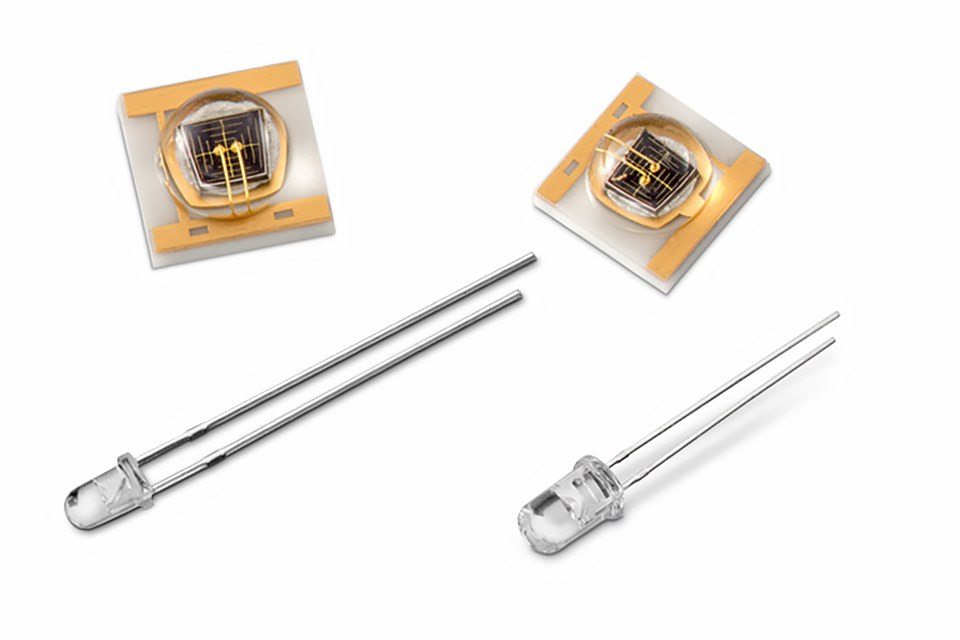Measuring the Oxygen Content of Blood with LEDs
Pulse oximetry is a non-invasive method for determining haemoglobin (Hb) saturation through oxygen in the blood and heart frequency. It uses the fact that oxygen-rich and oxygen-poor haemoglobin absorb red and infrared light differently. In order to measure the oxygen content reliably, LEDs with high performance, constant quality and low scattering are needed as light sources. With the WL-SMTW and WL-SITW series, Würth Elektronik has suitable red and infrared LEDs in its portfolio. In addition, there is a matching light sensor available: The phototransistor WL-STTW can reliably detect both red and infrared light.
Pulse oximeters can use two different measurement methods to detect the oxygen content in the blood: transmissive oximetry passes two wavelengths of light through a body part, for example a fingertip or earlobe. Reflective oximetry is used in fitness trackers or smart watches. Both methods measure the oxygen content in the blood on the basis of two basic principles: First, they distinguish between oxygen-rich oxyhaemoglobin (HbO2) and oxygen-poor deoxyhaemoglobin (Hb), and then they detect the oxygen saturation only in the arterial blood.
Different absorption spectra of the blood components
Pulse oximeters take advantage of the fact that red and infrared light is absorbed differently by oxygen-rich and oxygen-poor blood: HbO2 absorbs more infrared light and less red light than Hb. Due to the higher reflection of red light it appears bright red. By contrast, Hb absorbs more red light and thus appears darker.
Transmissive pulse oximetry usually uses a red LED in the range of about 650 nm and an IR LED in the range of about 900 nm. Both LEDs screen a fingertip and a phototransistor on the other side captures the relative amount of absorbed red and IR light. A micro-controller then determines the proportion of Hb and HbO2 and calculates the oxygen content from the measured parameters. In fact, only the arterial blood is of interest. With pulse oximetry it is possible to detect the oxygen content only of arterial blood. This is based on the fact that the amount of absorbed red and infrared light varies with every heartbeat due to the pulsating changes in blood volume. By contrast, veins, bones and tissue show relative constant absorption characteristics.
Reliable measurements need the right components
The right components are essential to reliably determine the oxygen content of blood. The LEDs and photodetectors that are used are particularly important. Würth Elektronik's red LED 150224SS73100 is characterized by an exact wavelength of 652 nm and high efficiency. With a current of IF=20mA a typical luminous intensity of 130 mcd is achieved. In combination with a good phototransistor this results in a high signal-to-noise ratio. In order to obtain a good signal-to-noise ratio with the IR LED as well, it should have about twice the luminous intensity of the red LED in this application. The LED 15414194BA210 from the WL-SITW-SMT series is particularly suitable here, as it has a very high efficiency and a high radiation intensity. The phototransistor WL-STTW SMT, 1541411NBA2010 is recommended as light sensor. Although the component has the highest light sensitivity at a wavelength of 940 nm, it also detects light signals with a wavelength of 660 nm. Therefore, only one single phototransistor is needed for the measurement. The perfect emitter-detector combination from Würth Elektronik for pulse oximetry and other IR applications is available from stock in any quantity.
Further information can be found at we-online.de/web/en/wuerth_elektronik/start.php, katalog.we-online.de/en/led/WL-SITW and katalog.we-online.de/en/led/WL-STTW
About Würth Elektronik eiSos Group:
Würth Elektronik eiSos Group is a manufacturer of electronic and electromechanical components for the electronics industry and a technology company that spearheads pioneering electronic solutions. Würth Elektronik eiSos is one of the largest European manufacturers of passive components and is active in 50 countries. Production sites in Europe, Asia and North America supply a growing number of customers worldwide. - we-online.de/web/en/wuerth_elektronik/start.php

